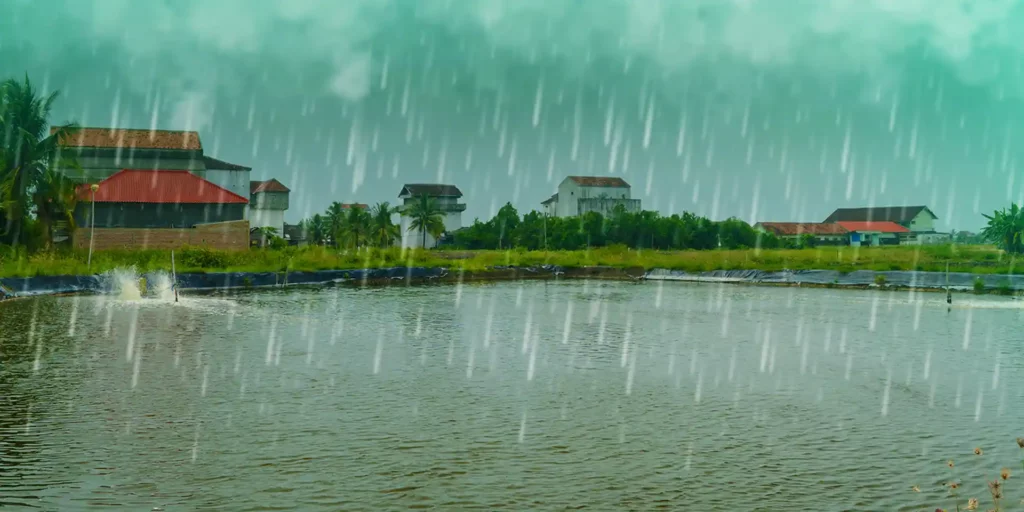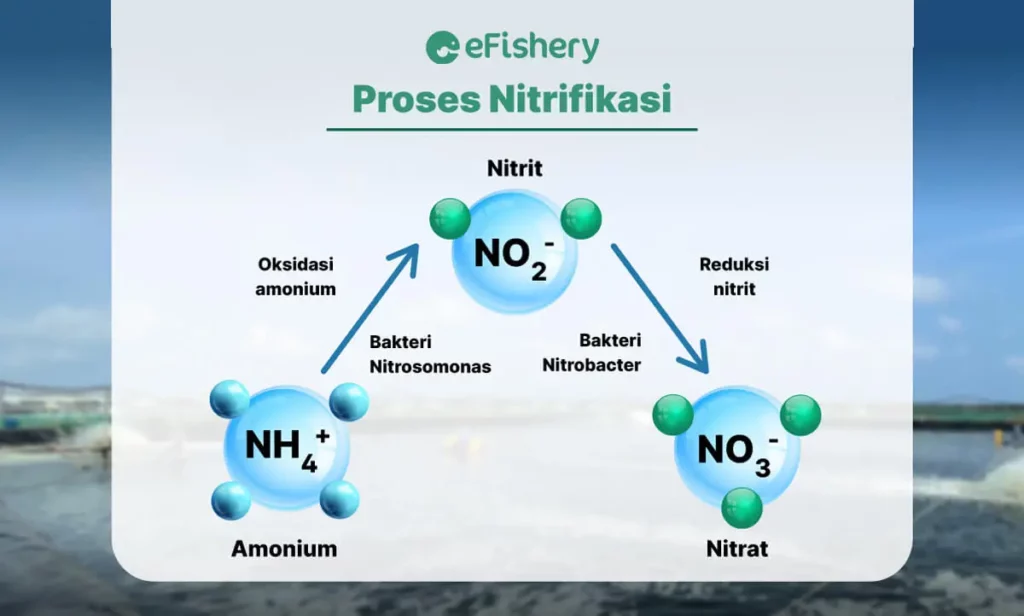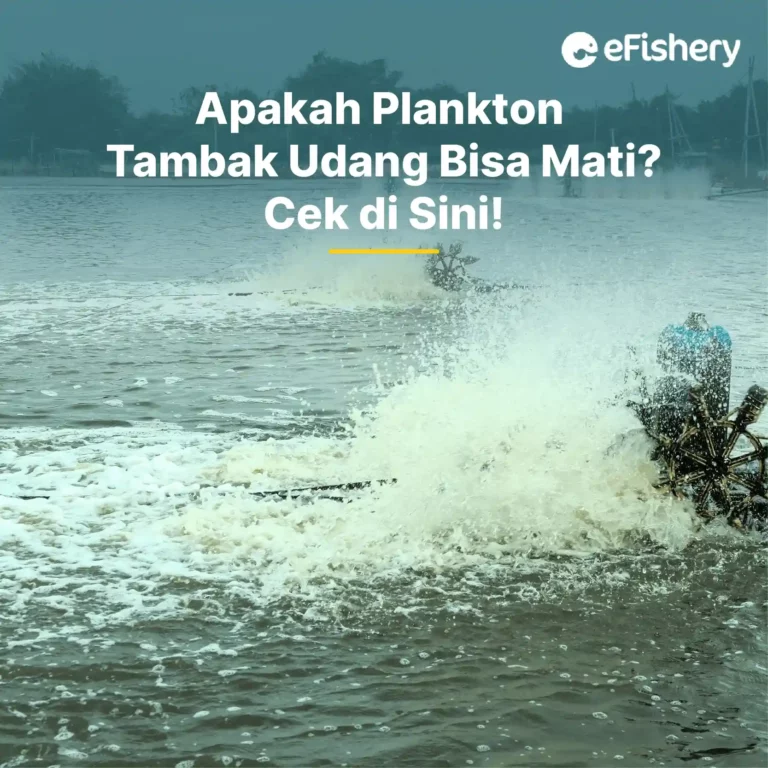Artikel Ini Telah Direview Oleh:

Nabilla Anggi
Magister Budidaya Perairan
Plankton in shrimp ponds has great benefits, namely as a natural feed and a producer of dissolved oxygen needed by shrimp. Plankton also helps reduce ammonia, nitrite, and nitrate compounds. With these many benefits, of course you as a farmer want plankton to always be in the pond. However, under certain conditions, can shrimp pond plankton die? If yes, will it be harmful to the survival of the cultured shrimp? Read more here!
Can Plankton in Shrimp Ponds Die?
The presence of plankton in shrimp ponds can affect metabolism and increase shrimp growth. However, shrimp pond plankton can experience mass death. This mass death of plankton can causing CO levels2 nor O2 in the pond decreases and becomes an unfulfilled source of energy.
One indication of the death of plankton is the color of the pond water becomes clearer. This can happen in a matter of a few hours. In addition, the brightness of the water increases drastically, followed by a shift in plankton which can be seen from the change in the color of the water. The color of pond water will change depending on the type of plankton that is dominant. Finally, colored foam will appear on the surface of the shrimp pond waters.
What Causes Plankton to Die?
After the explanation above, of course you must be aware of the mass death of plankton in shrimp ponds. This mass death of plankton can be caused by several things:
1. Plankton Has Been Through a Phase stationary and is on the way to the death phase
In its life cycle, plankton can grow rapidly in an exponential phase with the support of nutritional conditions in the pond. After going through the exponential phase, plankton will enter the phase stationary, which means that the growth graph is stable. When it enters this phase, plankton will enter the death phase. This causes plankton to die at one time.
2. Deteriorating Water Conditions or Extreme Weather Changes
Plankton will experience mass death if they are in water conditions that are not in accordance with their optimal conditions. An example is during the rainy season. When pond water conditions become more acidic and extreme changes in pH occur, the plankton will die.
In addition to changes in pH parameters, a drastic increase in temperature also affects the survival of plankton because it will cause an increase in metabolism.

3. Plankton dominance or Blooming Plankton
The rapid growth of one type of plankton is known as blooming plankton. The dominance of one type of plankton will cause competition for nutrients in the waters, so that several other types of plankton do not have the opportunity to utilize the available nutrients. This causes the dominance of one type of plankton in these waters and the death of other types of plankton.
4. Provision of Inappropriate Disinfectants
Excessive use of disinfectant will cause the water to turn transparent. This is an indication that the presence of plankton in the waters is lower.
5. There are predators
The existence of predators in the plankton environment is also one of the causes of reduced plankton populations or mass death of plankton.
How to Overcome Dead Plankton in Shrimp Ponds
One of the factors causing mass death in the plankton mentioned above is a sudden change in water quality. For example, heavy rains can cause sudden severe damage to plankton growth. To maintain plankton from various changes in conditions, there are a number of things that you need to prepare as follows:
- Nutrition
The addition of nutrients for plankton can be provided through the addition fertilizers (organic and inorganic) as well as the addition of minerals (macro minerals and micro minerals).
- CO2
CO2 supplied from the atmosphere, shrimp, plankton respiration, buffers carbonate in the water, and the most important is the administration of probiotic lime.
- Enough Sunlight
Sufficient sunlight will help plankton photosynthesize and grow properly.
- Water Change
Farmers can do water changes 30-40% every morning, as water contains many minerals that plankton can use to grow.
- Use of the Waterwheel
The use of a water wheel is necessary, especially at night, so that the supply of dissolved oxygen in pond water is maintained. O level2 in water is important for plankton because plankton also consumes O2 at night and does not produce O2.
- Addition of Bacteria
One of the bacteria that can be used to maintain the amount of plankton in the water is nitrifying bacteria. These bacteria will help the process of nitrification (change from ammonia to nitrite, then to nitrate). However, its use needs to be limited and adjusted to prevent this from happening blooming plankton.
- Fermentation Addition
One way to maintain the amount of plankton is to increase the levels of nitrate compounds to an optimal level, namely 3.9-15.5 ppm. This can be done through the nitrification process. The nitrification process is the process of changing ammonia compounds into nitrates assisted by bacteria Nitrobacter And Nitrosomonas.

In order for the nitrification process to occur, it is necessary to have a fermentation process that produces the element carbon (C) for use by nitrifying bacteria. If the nitrification process goes well, the nitrate content in the pond will be optimal and the growth of plankton will run smoothly. However, farmers must also maintain plankton growth so that it does not occur blooming plankton.
Atasi Plankton Mati di Tambak dengan Konsultasi Budidaya di eFarm!
Need Help Regarding Shrimp Cultivation Business?
Fill in your personal data in the following form. Our team will immediately contact you via the number cellphone attached. Make sure the data entered is correct.
Itu dia beberapa informasi terkait permasalahan plankton tambak udang. Jika Bapak/Ibu ingin langsung berkonsultasi dan mendapatkan rekomendasi terkait pengelolaan yang tepat agar plankton tambak udang tetap terjaga, Bapak/Ibu bisa langsung mengakses fitur Cultivation Consultation in app eFarm secara GRATIS. Bapak/Ibu akan berkonsultasi langsung dengan Ahli Budidaya eFishery dan mengetahui tips menarik lainnya seputar budidaya udang.
Fill out the form above to consult at Cultivation Consultation secara FREE!

Nabilla Anggi - Magister Budidaya Perairan
Nabilla merupakan lulusan sarjana dan magister budidaya perairan serta memiliki pengalaman di dunia perikanan baik hatchery maupun pembesaran
Questions Regarding Plankton in Shrimp Ponds
Can. The death of plankton in shrimp ponds can be caused by various factors such as excess organic waste, overfeeding, shrimp waste fertilization, and drastic weather changes.
Signs of dead plankton in the pond are the appearance of brown foam on the surface of the pond and a change in the color of the water in the pond.
- Rokhim A, Arisandi, Abidah. 2009. Analysis of the abundance of phytoplankton and the availability of nutrients (NO3 and PO4) in the waters of the Kwanyar sub-district, Bangkalan regency. Marine Journal. Vol 2(2)l:7-15.
- Rumanti, M, S. Rudiyanti and MN Suparjo. 2014. Relationship Between Nitrate and Phosphate Content and Phytoplankton Abundance in the Bremi River, Pekalongan Regency. Diponegoro Journal of Maquares. (3)1:168-176.
- Supono. 2018. Water Quality Management for Shrimp Farming. Bandar Lampung: AURA
